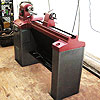Here’s also a way of making thin strips and thought it was a pretty good way of doing them.. Here’s how it works you take the piece of wood you want to cut the strips from and put it just next to or touching the blade (stock is in between the fence and the blade) then you take and clamp a piece or wood on your guide rail that your fence rides on. Then you make spacers the thickness of the strips you want to make(surface plainer ). What you do then is take a spacer and place it in between the edge of the wood you clamped to your guide rail and the fence part that rides on the rail and every time you make another strip you add another spacer from the ones you cut. That way they all come out the same size as the spacer ( basically you need to have different size spacers for templates but one nice thing about it is that if you need to repeat this process later down the road you can have the exact same size ) . I hoped I explained it well enough for everybody to understand …Does this make sense?
Richard Poitras
Central, Michigan....
01-02-2006




 Reply With Quote
Reply With Quote



